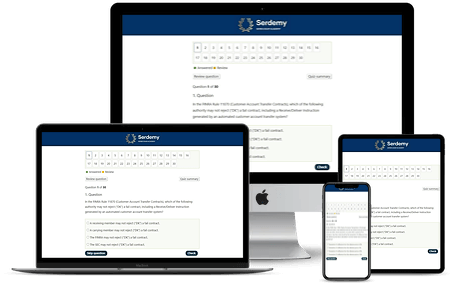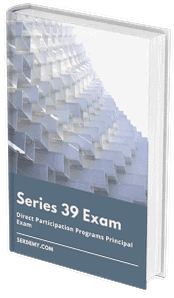Quiz-summary
0 of 30 questions completed
Questions:
- 1
- 2
- 3
- 4
- 5
- 6
- 7
- 8
- 9
- 10
- 11
- 12
- 13
- 14
- 15
- 16
- 17
- 18
- 19
- 20
- 21
- 22
- 23
- 24
- 25
- 26
- 27
- 28
- 29
- 30
Information
Premium Practice Questions
You have already completed the quiz before. Hence you can not start it again.
Quiz is loading...
You must sign in or sign up to start the quiz.
You have to finish following quiz, to start this quiz:
Results
0 of 30 questions answered correctly
Your time:
Time has elapsed
Categories
- Not categorized 0%
- 1
- 2
- 3
- 4
- 5
- 6
- 7
- 8
- 9
- 10
- 11
- 12
- 13
- 14
- 15
- 16
- 17
- 18
- 19
- 20
- 21
- 22
- 23
- 24
- 25
- 26
- 27
- 28
- 29
- 30
- Answered
- Review
-
Question 1 of 30
1. Question
Ananya, a registered representative, is conducting due diligence on a new, non-traded real estate limited partnership for her high-net-worth client, Mr. Chen, who is an accredited investor seeking long-term growth and tax-advantaged income. Mr. Chen understands and accepts the illiquidity associated with such an investment. In her analysis of the offering documents, which of the following factors should Ananya consider most critical to the potential success of the partnership?
Correct
No calculation is required for this conceptual question. The fundamental analysis of a Direct Participation Program, such as a real estate limited partnership, requires a registered representative to prioritize the program’s underlying economic viability and the capabilities of its management. The primary consideration in due diligence is the track record, experience, and integrity of the General Partner. The GP is responsible for managing the partnership’s assets and making all business decisions. A program’s success or failure is almost entirely dependent on the GP’s ability to execute the business plan, manage properties effectively, control costs, and navigate the real estate market. Potential conflicts of interest, such as the GP charging excessive fees or engaging in self-dealing, must also be thoroughly investigated. While tax benefits are a significant feature of many DPPs, they are secondary to the investment’s potential to be profitable. A program that generates large tax losses but ultimately fails due to mismanagement results in a total loss of the investor’s principal, making the tax benefits irrelevant. Therefore, evaluating the GP’s past performance with similar programs, their financial stability, and the overall economic soundness of the proposed venture is the most critical step in determining the suitability of the investment.
Incorrect
No calculation is required for this conceptual question. The fundamental analysis of a Direct Participation Program, such as a real estate limited partnership, requires a registered representative to prioritize the program’s underlying economic viability and the capabilities of its management. The primary consideration in due diligence is the track record, experience, and integrity of the General Partner. The GP is responsible for managing the partnership’s assets and making all business decisions. A program’s success or failure is almost entirely dependent on the GP’s ability to execute the business plan, manage properties effectively, control costs, and navigate the real estate market. Potential conflicts of interest, such as the GP charging excessive fees or engaging in self-dealing, must also be thoroughly investigated. While tax benefits are a significant feature of many DPPs, they are secondary to the investment’s potential to be profitable. A program that generates large tax losses but ultimately fails due to mismanagement results in a total loss of the investor’s principal, making the tax benefits irrelevant. Therefore, evaluating the GP’s past performance with similar programs, their financial stability, and the overall economic soundness of the proposed venture is the most critical step in determining the suitability of the investment.
-
Question 2 of 30
2. Question
Lin, a sophisticated investor, maintains a long margin account that currently has a Special Memorandum Account (SMA) balance of $10,000. The securities in her account have a market value well above the minimum maintenance requirement. Lin is evaluating several potential transactions and market events. Which of the following events would NOT cause a change to her existing $10,000 SMA balance?
Correct
The final answer is that a decline in market value does not change the SMA balance. Initial SMA = $10,000 Event: Market value of securities declines. Result: Equity in the account decreases, and buying power may be restricted, but the SMA balance itself is not reduced by market fluctuations. Final SMA = $10,000 Change to SMA = $0. The Special Memorandum Account, or SMA, is a line of credit that is established in a margin account when the equity in the account exceeds the Regulation T requirement of 50% of the current market value. Several events can increase SMA, including the deposit of cash, the appreciation of securities in the account which creates excess equity, the deposit of marginable securities, and the receipt of cash dividends or interest. Selling securities also increases SMA by an amount equal to 50% of the sales proceeds. Conversely, SMA is decreased when the customer uses this line of credit, for instance, by withdrawing cash or by purchasing additional securities on margin. A key principle of the SMA is that once it is created, it is not reduced by a subsequent decline in the market value of the securities. This is a concept often referred to as “SMA locks in”. While a market decline will reduce the account’s equity and may trigger a maintenance call if the decline is severe enough, it does not erase the existing SMA balance. The SMA figure represents a historical record of the highest line of credit established, which can only be reduced by the customer’s direct actions of using it. Therefore, a change in the portfolio’s market value, in and of itself, has no impact on the recorded SMA balance.
Incorrect
The final answer is that a decline in market value does not change the SMA balance. Initial SMA = $10,000 Event: Market value of securities declines. Result: Equity in the account decreases, and buying power may be restricted, but the SMA balance itself is not reduced by market fluctuations. Final SMA = $10,000 Change to SMA = $0. The Special Memorandum Account, or SMA, is a line of credit that is established in a margin account when the equity in the account exceeds the Regulation T requirement of 50% of the current market value. Several events can increase SMA, including the deposit of cash, the appreciation of securities in the account which creates excess equity, the deposit of marginable securities, and the receipt of cash dividends or interest. Selling securities also increases SMA by an amount equal to 50% of the sales proceeds. Conversely, SMA is decreased when the customer uses this line of credit, for instance, by withdrawing cash or by purchasing additional securities on margin. A key principle of the SMA is that once it is created, it is not reduced by a subsequent decline in the market value of the securities. This is a concept often referred to as “SMA locks in”. While a market decline will reduce the account’s equity and may trigger a maintenance call if the decline is severe enough, it does not erase the existing SMA balance. The SMA figure represents a historical record of the highest line of credit established, which can only be reduced by the customer’s direct actions of using it. Therefore, a change in the portfolio’s market value, in and of itself, has no impact on the recorded SMA balance.
-
Question 3 of 30
3. Question
A registered representative, Kenji, is developing a one-page flyer to be sent to 50 retail clients. The flyer promotes the “Apex Value Fund,” a large-cap equity mutual fund. The main feature of the flyer is a prominent graphic stating: “Apex Value Fund: Ranked in the Top 5% of its category for the 1-year period ending last quarter by Morningstar.” The flyer also includes the required legend that past performance does not guarantee future results and directs clients to the firm’s website for a prospectus. A principal at the firm reviews the flyer for compliance with FINRA Rule 2210 and 2212. Which of the following identifies a compliance violation that would require the principal to reject the flyer?
Correct
The marketing material is non-compliant with FINRA rules governing communications with the public. Specifically, under FINRA Rule 2212, when a member firm uses an investment company ranking in retail communications, it must provide specific disclosures to ensure the information is not misleading. The communication must disclose the name of the category, the number of investment companies in the category, the name of the ranking entity, the publisher of the ranking, the period on which the ranking is based, and the criteria on which the ranking is based. In this scenario, the flyer fails to disclose the total number of funds within the “U.S. Large-Cap Value” category. Stating a fund is in the top 5% is potentially misleading without the context of the total universe of funds. A top 5% ranking in a category of 20 funds is far less significant than a top 5% ranking in a category of 500 funds. This omission violates the requirement for the communication to be fair and balanced as mandated by the broader principles of FINRA Rule 2210. The rule is designed to prevent firms from cherry-picking data or presenting rankings in a way that exaggerates a fund’s performance relative to its peers.
Incorrect
The marketing material is non-compliant with FINRA rules governing communications with the public. Specifically, under FINRA Rule 2212, when a member firm uses an investment company ranking in retail communications, it must provide specific disclosures to ensure the information is not misleading. The communication must disclose the name of the category, the number of investment companies in the category, the name of the ranking entity, the publisher of the ranking, the period on which the ranking is based, and the criteria on which the ranking is based. In this scenario, the flyer fails to disclose the total number of funds within the “U.S. Large-Cap Value” category. Stating a fund is in the top 5% is potentially misleading without the context of the total universe of funds. A top 5% ranking in a category of 20 funds is far less significant than a top 5% ranking in a category of 500 funds. This omission violates the requirement for the communication to be fair and balanced as mandated by the broader principles of FINRA Rule 2210. The rule is designed to prevent firms from cherry-picking data or presenting rankings in a way that exaggerates a fund’s performance relative to its peers.
-
Question 4 of 30
4. Question
An assessment of a registered representative’s proposed client outreach reveals a plan to distribute a firm-generated research report via email. The report covers a speculative small-cap security. The representative, Kenji, intends to send this email to 35 of his individual clients, each of whom has been verified as an accredited investor with a net worth greater than $5 million but less than the $50 million threshold for institutional account status. According to FINRA Rule 2210, what is the correct classification of this email and its associated supervisory requirement?
Correct
The communication is classified as retail communication under FINRA Rule 2210. The key determinant is the number and type of recipients. Retail communication is defined as any written communication, including electronic, that is distributed or made available to more than 25 retail investors within any 30-calendar-day period. In this scenario, the email is being sent to 35 individuals. Although these individuals are high-net-worth and qualify as accredited investors under Regulation D, they do not meet the specific definition of an institutional investor for the purposes of FINRA’s communication rules. FINRA Rule 2210(a)(4) defines an institutional investor as specific entities like banks, insurance companies, registered investment companies, or any person (natural or legal) with total assets of at least $50 million. Since the clients, despite being wealthy, do not meet this higher threshold, they are considered retail investors. Because the communication is directed to more than 25 retail investors, it falls under the category of retail communication. A primary requirement for retail communication under FINRA Rule 2210(b)(1) is that it must be approved by an appropriately qualified registered principal of the member firm before its use. The fact that the communication contains a firm-generated research report does not negate this requirement; the act of distributing the report to a retail audience is the regulated event that necessitates principal pre-approval.
Incorrect
The communication is classified as retail communication under FINRA Rule 2210. The key determinant is the number and type of recipients. Retail communication is defined as any written communication, including electronic, that is distributed or made available to more than 25 retail investors within any 30-calendar-day period. In this scenario, the email is being sent to 35 individuals. Although these individuals are high-net-worth and qualify as accredited investors under Regulation D, they do not meet the specific definition of an institutional investor for the purposes of FINRA’s communication rules. FINRA Rule 2210(a)(4) defines an institutional investor as specific entities like banks, insurance companies, registered investment companies, or any person (natural or legal) with total assets of at least $50 million. Since the clients, despite being wealthy, do not meet this higher threshold, they are considered retail investors. Because the communication is directed to more than 25 retail investors, it falls under the category of retail communication. A primary requirement for retail communication under FINRA Rule 2210(b)(1) is that it must be approved by an appropriately qualified registered principal of the member firm before its use. The fact that the communication contains a firm-generated research report does not negate this requirement; the act of distributing the report to a retail audience is the regulated event that necessitates principal pre-approval.
-
Question 5 of 30
5. Question
A registered representative at an established FINRA member firm, Kenji, is preparing three different communications. The first is a personalized email to 15 of his high-net-worth retail clients summarizing a firm-approved research report. The second is a slide presentation for a seminar he will host for about 50 prospective retail clients, which illustrates the mechanics of covered call writing. The third is a detailed portfolio proposal for a meeting with the chief investment officer of a large public university’s endowment fund (total assets over $100 million). An assessment of Kenji’s plan under FINRA Rule 2210 would conclude that:
Correct
This scenario requires analyzing three distinct communications under FINRA Rule 2210, which categorizes communications based on the audience to determine the required level of supervision and approval. The first communication is an email to 15 existing retail clients. According to FINRA Rule 2210, any written communication, including electronic, that is distributed or made available to 25 or fewer retail investors within any 30 calendar-day period is defined as correspondence. Correspondence does not require pre-use approval by a principal. However, it is subject to the firm’s supervisory and review procedures, which may be conducted either before or after distribution, depending on the firm’s policies. The second communication is a script for a public seminar for approximately 50 retail investors. Any communication distributed or made available to more than 25 retail investors within a 30-day period is defined as retail communication. Retail communication requires pre-use approval by an appropriately qualified registered principal. Because the content involves options strategies, FINRA rules and Cboe rules mandate that the approval must come from a Registered Options Principal (ROP). The use of hypothetical illustrations also carries strict requirements to ensure they are fair, balanced, and not misleading. The third communication is a presentation deck for a university treasurer regarding the endowment fund. A university with assets of at least $50 million is considered an institutional investor. Communication that is distributed or made available only to institutional investors is defined as institutional communication. This category has the least restrictive supervisory requirement. It does not require prior principal approval, provided the firm has established written procedures for the supervision and review of such communications by a registered principal and trains its associated persons on these procedures. Therefore, each communication falls into a different category with a distinct supervisory requirement: correspondence is subject to review, retail communication requires pre-use principal approval (specifically by an ROP in this case), and institutional communication is governed by the firm’s internal supervisory policies and procedures.
Incorrect
This scenario requires analyzing three distinct communications under FINRA Rule 2210, which categorizes communications based on the audience to determine the required level of supervision and approval. The first communication is an email to 15 existing retail clients. According to FINRA Rule 2210, any written communication, including electronic, that is distributed or made available to 25 or fewer retail investors within any 30 calendar-day period is defined as correspondence. Correspondence does not require pre-use approval by a principal. However, it is subject to the firm’s supervisory and review procedures, which may be conducted either before or after distribution, depending on the firm’s policies. The second communication is a script for a public seminar for approximately 50 retail investors. Any communication distributed or made available to more than 25 retail investors within a 30-day period is defined as retail communication. Retail communication requires pre-use approval by an appropriately qualified registered principal. Because the content involves options strategies, FINRA rules and Cboe rules mandate that the approval must come from a Registered Options Principal (ROP). The use of hypothetical illustrations also carries strict requirements to ensure they are fair, balanced, and not misleading. The third communication is a presentation deck for a university treasurer regarding the endowment fund. A university with assets of at least $50 million is considered an institutional investor. Communication that is distributed or made available only to institutional investors is defined as institutional communication. This category has the least restrictive supervisory requirement. It does not require prior principal approval, provided the firm has established written procedures for the supervision and review of such communications by a registered principal and trains its associated persons on these procedures. Therefore, each communication falls into a different category with a distinct supervisory requirement: correspondence is subject to review, retail communication requires pre-use principal approval (specifically by an ROP in this case), and institutional communication is governed by the firm’s internal supervisory policies and procedures.
-
Question 6 of 30
6. Question
Ananya, a municipal securities representative at a FINRA member firm, creates a blog post to educate potential clients. The post provides a detailed analysis of the creditworthiness of a new issue of General Obligation (GO) bonds from a local municipality. The blog platform allows for public comments, and Ananya plans to engage in unscripted, real-time discussions with readers in the comment section. According to MSRB and FINRA rules, which statement accurately describes the supervisory obligations of Ananya’s firm regarding this activity?
Correct
The supervisory requirements for a registered representative’s electronic communications are dictated by their format and content. Under both FINRA Rule 2210 and MSRB Rule G-21, a distinction is made between static content and interactive electronic forums. The initial blog post, which is prepared and posted for public viewing, is considered static content. Because it is available to more than 25 retail investors within a 30-day period, it qualifies as retail communication. As such, this static post must be reviewed and approved by an appropriately qualified principal before it is published. For communications concerning municipal securities, this would typically be a Municipal Securities Principal (Series 53) or a General Securities Principal (Series 24). The comment section of the blog, where Ananya engages in spontaneous, real-time dialogue with the public, is considered an interactive electronic forum. This activity is treated similarly to a public appearance, such as a seminar or speaking engagement. The individual, unscripted comments and replies do not require prior principal approval. However, this does not mean the activity is unsupervised. The member firm is required to establish and maintain specific written policies and procedures for the supervision of these interactive forums. This includes training representatives on what is permissible, conducting risk-based reviews of the content, and retaining records of the communications as required. Therefore, the firm’s obligation is twofold: pre-approval for the static content and supervision through established procedures for the interactive portion.
Incorrect
The supervisory requirements for a registered representative’s electronic communications are dictated by their format and content. Under both FINRA Rule 2210 and MSRB Rule G-21, a distinction is made between static content and interactive electronic forums. The initial blog post, which is prepared and posted for public viewing, is considered static content. Because it is available to more than 25 retail investors within a 30-day period, it qualifies as retail communication. As such, this static post must be reviewed and approved by an appropriately qualified principal before it is published. For communications concerning municipal securities, this would typically be a Municipal Securities Principal (Series 53) or a General Securities Principal (Series 24). The comment section of the blog, where Ananya engages in spontaneous, real-time dialogue with the public, is considered an interactive electronic forum. This activity is treated similarly to a public appearance, such as a seminar or speaking engagement. The individual, unscripted comments and replies do not require prior principal approval. However, this does not mean the activity is unsupervised. The member firm is required to establish and maintain specific written policies and procedures for the supervision of these interactive forums. This includes training representatives on what is permissible, conducting risk-based reviews of the content, and retaining records of the communications as required. Therefore, the firm’s obligation is twofold: pre-approval for the static content and supervision through established procedures for the interactive portion.
-
Question 7 of 30
7. Question
Anya, a registered representative, is preparing for a seminar targeting high-net-worth individuals. She designs a one-page handout, which qualifies as retail communication, that compares a newly issued, tax-exempt municipal general obligation bond to a taxable corporate bond with a similar credit rating and maturity. The handout prominently features the attractive tax-free income of the municipal security. To ensure compliance with MSRB Rule G-21, which of the following is a mandatory consideration for this comparative piece?
Correct
The core requirement is that the communication must be fair and balanced, explicitly disclosing that the tax-exempt feature of the municipal bond may not be suitable or beneficial for all investors. MSRB Rule G-21, which governs advertising by brokers, dealers, and municipal securities dealers, mandates that all communications with the public be based on principles of fair dealing and good faith. They must not contain any false, exaggerated, unwarranted, promissory, or misleading statements or claims. When a municipal security’s tax-exempt status is presented as a key benefit in a comparison against a taxable investment like a corporate bond, it is a material omission to not clarify the circumstances under which this benefit would be diminished or nonexistent. The value of tax exemption is contingent upon an investor’s marginal tax rate; for an individual in a low tax bracket, the benefit is minimal. Furthermore, for investments held within a tax-deferred retirement account, such as an IRA or 401(k), the tax-exempt feature is redundant and offers no additional advantage, as the income within such accounts already grows tax-deferred. Therefore, to ensure the comparison is not misleading, the communication must include a clear disclosure explaining these limitations. This ensures the retail client understands that the advertised benefit is not universal and depends entirely on their personal financial and tax situation.
Incorrect
The core requirement is that the communication must be fair and balanced, explicitly disclosing that the tax-exempt feature of the municipal bond may not be suitable or beneficial for all investors. MSRB Rule G-21, which governs advertising by brokers, dealers, and municipal securities dealers, mandates that all communications with the public be based on principles of fair dealing and good faith. They must not contain any false, exaggerated, unwarranted, promissory, or misleading statements or claims. When a municipal security’s tax-exempt status is presented as a key benefit in a comparison against a taxable investment like a corporate bond, it is a material omission to not clarify the circumstances under which this benefit would be diminished or nonexistent. The value of tax exemption is contingent upon an investor’s marginal tax rate; for an individual in a low tax bracket, the benefit is minimal. Furthermore, for investments held within a tax-deferred retirement account, such as an IRA or 401(k), the tax-exempt feature is redundant and offers no additional advantage, as the income within such accounts already grows tax-deferred. Therefore, to ensure the comparison is not misleading, the communication must include a clear disclosure explaining these limitations. This ensures the retail client understands that the advertised benefit is not universal and depends entirely on their personal financial and tax situation.
-
Question 8 of 30
8. Question
A registered representative, Leto, finds a highly favorable article about a specific emerging market ETF in a reputable, unaffiliated financial magazine. Believing the article perfectly articulates the potential benefits of the ETF, he plans to scan it and email the PDF to 40 of his retail clients who have expressed interest in international investments. To comply with FINRA Rule 2210 regarding communications with the public, what is the most critical supervisory step Leto’s firm must take before this distribution can occur?
Correct
The communication in this scenario is classified as retail communication under FINRA Rule 2210. Retail communication is defined as any written, including electronic, communication that is distributed or made available to more than 25 retail investors within any 30 calendar day period. The plan to email the article to 40 retail clients clearly exceeds this threshold. When a member firm distributes content prepared by an independent third party, such as an article from a financial journal, it is known as an independently prepared reprint (IPR). By distributing the IPR, the firm is considered to have adopted its content. Therefore, the firm becomes responsible for ensuring the content is fair, balanced, and not misleading, just as if the firm had created the material itself. The primary regulatory requirement for retail communication is that it must be reviewed and approved by a qualified registered principal of the firm before its first use or distribution. This pre-approval process ensures that the communication complies with all applicable standards, including providing a sound basis for evaluating the facts, not omitting material information, and not making exaggerated or promissory claims. The principal’s signature and date on the communication signify this approval and must be maintained in the firm’s records.
Incorrect
The communication in this scenario is classified as retail communication under FINRA Rule 2210. Retail communication is defined as any written, including electronic, communication that is distributed or made available to more than 25 retail investors within any 30 calendar day period. The plan to email the article to 40 retail clients clearly exceeds this threshold. When a member firm distributes content prepared by an independent third party, such as an article from a financial journal, it is known as an independently prepared reprint (IPR). By distributing the IPR, the firm is considered to have adopted its content. Therefore, the firm becomes responsible for ensuring the content is fair, balanced, and not misleading, just as if the firm had created the material itself. The primary regulatory requirement for retail communication is that it must be reviewed and approved by a qualified registered principal of the firm before its first use or distribution. This pre-approval process ensures that the communication complies with all applicable standards, including providing a sound basis for evaluating the facts, not omitting material information, and not making exaggerated or promissory claims. The principal’s signature and date on the communication signify this approval and must be maintained in the firm’s records.
-
Question 9 of 30
9. Question
Anya, a registered representative at a well-established broker-dealer, is preparing a slide deck for a public investment seminar she will host next month. The seminar is advertised to the general public and will discuss the firm’s recommended mutual fund asset allocation models. She anticipates an audience of approximately 40 retail prospects and clients. What is the primary supervisory obligation concerning her slide deck under FINRA Rule 2210?
Correct
Under FINRA Rule 2210, communications with the public are categorized into three types: institutional, retail, and correspondence. The supervisory requirements differ for each category. Retail communication is defined as any written or electronic communication that is distributed or made available to more than 25 retail investors within any 30 calendar-day period. A retail investor is any person other than an institutional investor, regardless of whether they have an account with the firm. A seminar presentation, slide deck, or any handout material intended for a public audience of this nature falls squarely under the definition of retail communication. The rule mandates that a qualified registered principal of the member firm must review and approve all retail communications before they are used or distributed to the public. This pre-use approval is a critical supervisory step to ensure the material is fair, balanced, not misleading, and complies with all applicable FINRA rules and federal securities laws. This requirement applies regardless of whether the communication is created by a new or an experienced representative. The content of the communication, such as discussing specific products like mutual funds, further underscores the importance of this principal review. The primary obligation is this internal pre-use approval by a principal. Filing with FINRA is a separate requirement that applies to specific types of retail communications or to firms in their first year of business, but it does not replace the fundamental need for prior principal approval.
Incorrect
Under FINRA Rule 2210, communications with the public are categorized into three types: institutional, retail, and correspondence. The supervisory requirements differ for each category. Retail communication is defined as any written or electronic communication that is distributed or made available to more than 25 retail investors within any 30 calendar-day period. A retail investor is any person other than an institutional investor, regardless of whether they have an account with the firm. A seminar presentation, slide deck, or any handout material intended for a public audience of this nature falls squarely under the definition of retail communication. The rule mandates that a qualified registered principal of the member firm must review and approve all retail communications before they are used or distributed to the public. This pre-use approval is a critical supervisory step to ensure the material is fair, balanced, not misleading, and complies with all applicable FINRA rules and federal securities laws. This requirement applies regardless of whether the communication is created by a new or an experienced representative. The content of the communication, such as discussing specific products like mutual funds, further underscores the importance of this principal review. The primary obligation is this internal pre-use approval by a principal. Filing with FINRA is a separate requirement that applies to specific types of retail communications or to firms in their first year of business, but it does not replace the fundamental need for prior principal approval.
-
Question 10 of 30
10. Question
Mateo, a municipal securities representative, hosts a seminar about a new issue of General Obligation bonds. The seminar is advertised in a local newspaper and is attended by a mix of 40 individuals, including existing retail clients, members of the general public, and two representatives from a local credit union. Following the seminar, Mateo sends a standardized follow-up email to 30 of the retail prospects who attended, thanking them for their time and suggesting a private consultation. The email content was created by Mateo and was not reviewed by a principal. An assessment of Mateo’s actions under FINRA and MSRB communication rules would find that:
Correct
The scenario involves evaluating multiple communication activities against FINRA and MSRB rules. The primary rules governing this are FINRA Rule 2210 (Communications with the Public) and MSRB Rule G-21 (Advertising). The seminar, advertised to the general public and attended by retail prospects, means the materials used, such as the slide deck, are classified as retail communication. Retail communication is defined as any written communication, including electronic, that is distributed or made available to more than 25 retail investors within any 30-calendar-day period. Such communications require prior approval by a qualified registered principal of the member firm before use. The follow-up email, sent to 30 attendees, also meets the definition of retail communication because it was sent to more than 25 prospective customers within a 30-day period. Therefore, this email also required pre-approval by a principal. Had the email been sent to 25 or fewer retail investors, it would have been classified as correspondence, which is subject to review but not necessarily pre-approval, depending on the firm’s procedures. The presence of an institutional investor at the seminar does not change the classification of the seminar materials or the broadly distributed follow-up email to retail communication, as the standard is based on the audience to whom it is made available. The failure to obtain prior principal approval for the email sent to 30 individuals constitutes a violation.
Incorrect
The scenario involves evaluating multiple communication activities against FINRA and MSRB rules. The primary rules governing this are FINRA Rule 2210 (Communications with the Public) and MSRB Rule G-21 (Advertising). The seminar, advertised to the general public and attended by retail prospects, means the materials used, such as the slide deck, are classified as retail communication. Retail communication is defined as any written communication, including electronic, that is distributed or made available to more than 25 retail investors within any 30-calendar-day period. Such communications require prior approval by a qualified registered principal of the member firm before use. The follow-up email, sent to 30 attendees, also meets the definition of retail communication because it was sent to more than 25 prospective customers within a 30-day period. Therefore, this email also required pre-approval by a principal. Had the email been sent to 25 or fewer retail investors, it would have been classified as correspondence, which is subject to review but not necessarily pre-approval, depending on the firm’s procedures. The presence of an institutional investor at the seminar does not change the classification of the seminar materials or the broadly distributed follow-up email to retail communication, as the standard is based on the audience to whom it is made available. The failure to obtain prior principal approval for the email sent to 30 individuals constitutes a violation.
-
Question 11 of 30
11. Question
Anya, a registered representative at a member firm, designs a one-page flyer titled “An Introduction to Equity Options” to send to a large list of prospective retail clients. The flyer defines what call and put options are, explains basic terms like strike price and expiration date, and includes a brief section stating that options can be used for various purposes, including hedging existing stock positions or for speculation. The flyer does not contain any performance projections, pricing information, or recommendations of any specific option or underlying security. Assessment of this situation shows that specific regulatory handling is required. What is the correct regulatory treatment for this flyer before it can be distributed?
Correct
This communication is defined as retail communication under FINRA Rule 2210 because it is a written communication distributed or made available to more than 25 retail investors within any 30 calendar-day period. Because its subject matter is options, it is also governed by the specific requirements of FINRA Rule 2220 and Cboe rules on options communications. According to these rules, all retail communications concerning options must be approved in writing by a Registered Options Principal (ROP) before use. Furthermore, retail communications that discuss options must be preceded or accompanied by the current Options Disclosure Document (ODD). An exemption from the ODD delivery requirement exists for communications that are limited to a general description of the options market, do not contain recommendations, and do not project performance. However, this flyer goes beyond a general description by mentioning specific strategies, namely using options for hedging or speculation. The discussion of strategies, even without specific recommendations, removes the communication from the exemption category and mandates that the ODD must be furnished to the recipient at or before the time the flyer is delivered. Classifying the flyer as correspondence is incorrect because it is a standardized piece intended for broad distribution, not a personalized message to a small group. Classifying it as institutional communication is also incorrect as it is being sent to potential retail clients, not qualified institutional buyers.
Incorrect
This communication is defined as retail communication under FINRA Rule 2210 because it is a written communication distributed or made available to more than 25 retail investors within any 30 calendar-day period. Because its subject matter is options, it is also governed by the specific requirements of FINRA Rule 2220 and Cboe rules on options communications. According to these rules, all retail communications concerning options must be approved in writing by a Registered Options Principal (ROP) before use. Furthermore, retail communications that discuss options must be preceded or accompanied by the current Options Disclosure Document (ODD). An exemption from the ODD delivery requirement exists for communications that are limited to a general description of the options market, do not contain recommendations, and do not project performance. However, this flyer goes beyond a general description by mentioning specific strategies, namely using options for hedging or speculation. The discussion of strategies, even without specific recommendations, removes the communication from the exemption category and mandates that the ODD must be furnished to the recipient at or before the time the flyer is delivered. Classifying the flyer as correspondence is incorrect because it is a standardized piece intended for broad distribution, not a personalized message to a small group. Classifying it as institutional communication is also incorrect as it is being sent to potential retail clients, not qualified institutional buyers.
-
Question 12 of 30
12. Question
Ananya, a registered representative at a FINRA member firm, creates a two-minute educational video. The video provides a general overview of how creditworthiness is assessed for general obligation (GO) bonds and does not recommend any specific security. She plans to post this video to her public-facing professional social media page, which is accessible to anyone and followed by over 200 individuals, including current retail clients, prospects, and a few contacts who work at local institutional firms. According to FINRA and MSRB rules, which of the following correctly identifies the communication type and the required supervisory action?
Correct
This scenario involves a communication that will be made available to the public on a social media platform. According to FINRA Rule 2210, any written communication, which includes electronic and video content, that is distributed or made available to more than 25 retail investors within any 30 calendar day period is defined as retail communication. Since the representative’s professional networking page is public and has over 200 connections, including retail clients and prospects, it far exceeds the 25 retail investor threshold. Therefore, the video must be classified as retail communication. The rules for retail communication are stricter than for correspondence or institutional communication. Specifically, retail communication requires review and approval by an appropriately qualified registered principal before the communication is used or distributed. The content of the communication, which pertains to municipal securities, means that the approving principal must be qualified to supervise such activities, such as a General Securities Principal (Series 24) or a Municipal Securities Principal (Series 53). The critical step is obtaining this internal pre-approval from a principal at the firm. This is distinct from correspondence, which is directed to 25 or fewer retail investors and is subject to review, or institutional communication, which is directed only to institutional investors and has its own supervisory procedures. A general educational video about GO bonds does not typically require pre-filing with FINRA, which is a separate requirement reserved for specific types of communications, such as those for new member firms or those containing certain rankings or performance data.
Incorrect
This scenario involves a communication that will be made available to the public on a social media platform. According to FINRA Rule 2210, any written communication, which includes electronic and video content, that is distributed or made available to more than 25 retail investors within any 30 calendar day period is defined as retail communication. Since the representative’s professional networking page is public and has over 200 connections, including retail clients and prospects, it far exceeds the 25 retail investor threshold. Therefore, the video must be classified as retail communication. The rules for retail communication are stricter than for correspondence or institutional communication. Specifically, retail communication requires review and approval by an appropriately qualified registered principal before the communication is used or distributed. The content of the communication, which pertains to municipal securities, means that the approving principal must be qualified to supervise such activities, such as a General Securities Principal (Series 24) or a Municipal Securities Principal (Series 53). The critical step is obtaining this internal pre-approval from a principal at the firm. This is distinct from correspondence, which is directed to 25 or fewer retail investors and is subject to review, or institutional communication, which is directed only to institutional investors and has its own supervisory procedures. A general educational video about GO bonds does not typically require pre-filing with FINRA, which is a separate requirement reserved for specific types of communications, such as those for new member firms or those containing certain rankings or performance data.
-
Question 13 of 30
13. Question
A registered representative, Mateo, is creating a slide presentation for a public seminar on using options to generate income. One slide details a historical covered call strategy on a specific blue-chip stock over the previous 12 months. The slide accurately lists the premiums collected. Mateo proposes adding a concluding bullet point that states: “This demonstrates a potential annualized return of 14% based on the capital invested.” According to FINRA Rule 2220, what is the primary compliance issue with this proposed statement?
Correct
FINRA Rule 2220 and Cboe rules strictly govern how options are discussed in communications with the public. A primary objective of these rules is to ensure that communications are fair, balanced, and not misleading. One of the most critical prohibitions under these rules is against projecting or forecasting performance. Specifically, any statement that refers to a projected or annualized rate of return in an options communication is explicitly forbidden. While historical performance can be shown, it must adhere to stringent conditions. For instance, if performance is presented, it should cover at least a 12-month period, reflect all relevant costs such as commissions and fees, and be accompanied by disclosures about the risks involved and a statement that past performance does not guarantee future results. The act of taking historical data, such as premiums received over a period, and presenting it as an annualized rate of return is considered a prohibited projection. This is because it implies that the short term results could be consistently replicated over an entire year, which is speculative and potentially misleading to investors. Furthermore, all retail communications concerning options, which include seminars and their materials, must be pre-approved in writing by a Registered Options Principal (ROP). The communication must also be preceded or accompanied by the current Options Disclosure Document (ODD).
Incorrect
FINRA Rule 2220 and Cboe rules strictly govern how options are discussed in communications with the public. A primary objective of these rules is to ensure that communications are fair, balanced, and not misleading. One of the most critical prohibitions under these rules is against projecting or forecasting performance. Specifically, any statement that refers to a projected or annualized rate of return in an options communication is explicitly forbidden. While historical performance can be shown, it must adhere to stringent conditions. For instance, if performance is presented, it should cover at least a 12-month period, reflect all relevant costs such as commissions and fees, and be accompanied by disclosures about the risks involved and a statement that past performance does not guarantee future results. The act of taking historical data, such as premiums received over a period, and presenting it as an annualized rate of return is considered a prohibited projection. This is because it implies that the short term results could be consistently replicated over an entire year, which is speculative and potentially misleading to investors. Furthermore, all retail communications concerning options, which include seminars and their materials, must be pre-approved in writing by a Registered Options Principal (ROP). The communication must also be preceded or accompanied by the current Options Disclosure Document (ODD).
-
Question 14 of 30
14. Question
Kenji, a registered representative at a municipal securities dealer, is preparing a seminar for potential retail clients focused on local infrastructure financing. His presentation, which qualifies as retail communication, includes a slide comparing a new, unrated general obligation bond from his town with a highly-rated, insured revenue bond from a major metropolitan area. It also includes a chart illustrating the tax-equivalent yields of the local bond for individuals in different federal income tax brackets. The centerpiece of his presentation is a pre-recorded video statement from the town’s mayor. The mayor, who is not a client of Kenji’s firm, praises Kenji’s firm for its community focus and states that investing in the new bond is a “fantastic way for our citizens to support our town’s future.” A principal is reviewing the materials for compliance with FINRA and MSRB rules. Which component of the presentation would be the most direct and clear violation of public communication standards?
Correct
The video clip featuring the town’s mayor represents the most significant compliance issue. Under FINRA Rule 2210, which governs communications with the public, the use of testimonials is subject to very strict guidelines. A testimonial must be genuine and represent the typical experience of clients. The person providing the testimonial must have the knowledge and experience to be qualified to form a valid opinion. Furthermore, if any compensation, whether direct or indirect, of more than one hundred dollars is paid for the testimonial, this fact must be disclosed. The communication must also clearly state that the testimonial may not be representative of the experience of other customers and is not a guarantee of future performance or success. In this scenario, the mayor is not a client of the firm. Therefore, the testimonial is not based on any customer experience with the firm or its recommendations, making it inherently misleading. It functions as an endorsement rather than a genuine testimonial. Using a public official’s image and statement to encourage investment in a specific bond issue that the firm is promoting creates a strong potential for the communication to be misleading, implying a level of safety or endorsement that is not appropriate. MSRB Rule G-21, which covers advertising for municipal securities, also prohibits any advertisement that is materially false or misleading. While comparisons and yield calculations are permissible if presented fairly and with all necessary disclosures, a non-client endorsement is a more fundamental violation of the principles of fair and balanced communication.
Incorrect
The video clip featuring the town’s mayor represents the most significant compliance issue. Under FINRA Rule 2210, which governs communications with the public, the use of testimonials is subject to very strict guidelines. A testimonial must be genuine and represent the typical experience of clients. The person providing the testimonial must have the knowledge and experience to be qualified to form a valid opinion. Furthermore, if any compensation, whether direct or indirect, of more than one hundred dollars is paid for the testimonial, this fact must be disclosed. The communication must also clearly state that the testimonial may not be representative of the experience of other customers and is not a guarantee of future performance or success. In this scenario, the mayor is not a client of the firm. Therefore, the testimonial is not based on any customer experience with the firm or its recommendations, making it inherently misleading. It functions as an endorsement rather than a genuine testimonial. Using a public official’s image and statement to encourage investment in a specific bond issue that the firm is promoting creates a strong potential for the communication to be misleading, implying a level of safety or endorsement that is not appropriate. MSRB Rule G-21, which covers advertising for municipal securities, also prohibits any advertisement that is materially false or misleading. While comparisons and yield calculations are permissible if presented fairly and with all necessary disclosures, a non-client endorsement is a more fundamental violation of the principles of fair and balanced communication.
-
Question 15 of 30
15. Question
Anika, a registered representative, has prepared a standardized market analysis report on a new technology sector mutual fund. Her distribution plan involves emailing this report to 15 of her current retail clients and 15 institutional investors. Simultaneously, she intends to post the identical report on a password-protected section of her firm’s website, which is accessible to all 100 of the firm’s existing retail clients. In accordance with FINRA Rule 2210, what is the proper classification of this report and the corresponding supervisory requirement?
Correct
The communication is classified as retail communication. The determination is based on the total number of retail investors to whom the communication is distributed or made available. The distribution plan includes emailing 15 retail clients and making the report available to 100 existing retail clients via a website. This results in the communication being made available to a total of 115 retail investors (15 + 100). According to FINRA Rule 2210, any written communication, including electronic, that is distributed or made available to more than 25 retail investors within any 30-calendar-day period is defined as retail communication. Since the total number of retail investors is 115, which is greater than 25, the report meets this definition. The fact that it is also sent to institutional investors does not change its classification; if a communication is directed to both institutional and retail investors, it is treated as retail communication. Retail communications, with certain exceptions not applicable here, require review and approval by a registered principal of the member firm before the earlier of its use or filing with FINRA. Therefore, the report must be pre-approved by a registered principal before Anika can distribute it. The supervisory requirements for correspondence or institutional communication, which typically involve post-use review, are not sufficient in this case due to the scale of the retail distribution.
Incorrect
The communication is classified as retail communication. The determination is based on the total number of retail investors to whom the communication is distributed or made available. The distribution plan includes emailing 15 retail clients and making the report available to 100 existing retail clients via a website. This results in the communication being made available to a total of 115 retail investors (15 + 100). According to FINRA Rule 2210, any written communication, including electronic, that is distributed or made available to more than 25 retail investors within any 30-calendar-day period is defined as retail communication. Since the total number of retail investors is 115, which is greater than 25, the report meets this definition. The fact that it is also sent to institutional investors does not change its classification; if a communication is directed to both institutional and retail investors, it is treated as retail communication. Retail communications, with certain exceptions not applicable here, require review and approval by a registered principal of the member firm before the earlier of its use or filing with FINRA. Therefore, the report must be pre-approved by a registered principal before Anika can distribute it. The supervisory requirements for correspondence or institutional communication, which typically involve post-use review, are not sufficient in this case due to the scale of the retail distribution.
-
Question 16 of 30
16. Question
Anya, a registered representative at a member firm, has developed a script for a public webinar aimed at retail investors. The webinar, titled “Income Generation through Advanced Options,” discusses covered call writing and cash-secured put writing. The script includes hypothetical illustrations of potential returns based on historical volatility data and makes specific performance projections. Before the webinar can be advertised or presented, what is the primary regulatory requirement concerning this script under FINRA Rule 2220?
Correct
Under FINRA and Cboe rules governing communications with the public about options, any retail communication that includes projected performance illustrations must be submitted to FINRA’s Advertising Regulation Department for review at least 10 business days prior to its first use. This pre-filing requirement is a critical step designed to ensure that performance projections are not misleading, are balanced, and provide sufficient information about the risks involved. The webinar script, because it is intended for a public retail audience and contains specific performance projections, falls squarely into this category. In addition to the external filing with FINRA, the communication must also receive prior internal approval from a Registered Options Principal (ROP) of the member firm. The ROP is responsible for ensuring the communication is fair, balanced, and complies with all applicable rules, including the requirement that it be preceded or accompanied by the current Options Disclosure Document (ODD). Therefore, the two key, mandatory, and sequential steps are the internal ROP approval and the pre-filing with FINRA. Simply getting ROP approval is insufficient due to the inclusion of projections, and filing after the fact is not compliant. Misclassifying the communication would also lead to a failure to meet these specific and stringent requirements for options-related retail communications.
Incorrect
Under FINRA and Cboe rules governing communications with the public about options, any retail communication that includes projected performance illustrations must be submitted to FINRA’s Advertising Regulation Department for review at least 10 business days prior to its first use. This pre-filing requirement is a critical step designed to ensure that performance projections are not misleading, are balanced, and provide sufficient information about the risks involved. The webinar script, because it is intended for a public retail audience and contains specific performance projections, falls squarely into this category. In addition to the external filing with FINRA, the communication must also receive prior internal approval from a Registered Options Principal (ROP) of the member firm. The ROP is responsible for ensuring the communication is fair, balanced, and complies with all applicable rules, including the requirement that it be preceded or accompanied by the current Options Disclosure Document (ODD). Therefore, the two key, mandatory, and sequential steps are the internal ROP approval and the pre-filing with FINRA. Simply getting ROP approval is insufficient due to the inclusion of projections, and filing after the fact is not compliant. Misclassifying the communication would also lead to a failure to meet these specific and stringent requirements for options-related retail communications.
-
Question 17 of 30
17. Question
A registered representative at a FINRA member firm, Kenji, has drafted an email template discussing the strategic advantages of investing in a specific sector through exchange-traded funds (ETFs). He intends to personalize and send this email to a list of 35 potential clients he acquired from a trade show. The email contains his own analysis of the sector’s growth potential and a chart he created comparing the expense ratios of three leading ETFs in that sector. What is the correct classification of this communication and the associated supervisory requirement under FINRA Rule 2210?
Correct
The determination of the supervisory requirements for a communication depends on its classification under FINRA Rule 2210. The primary classifications are institutional, retail, and correspondence. The scenario involves sending an email to 40 prospective clients. Since these are individuals and not institutions like banks, insurance companies, or registered investment advisers, the communication is not institutional. The distinction between correspondence and retail communication is based on the number of recipients. Correspondence is defined as any written communication, including electronic, that is distributed or made available to 25 or fewer retail investors within any 30 calendar day period. A retail communication is any written communication, including electronic, that is distributed or made available to more than 25 retail investors within any 30 calendar day period. Because the representative plans to send the email to 40 prospective clients, which exceeds the 25 investor threshold, the communication is classified as a retail communication. Under FINRA Rule 2210, retail communications must generally be approved by an appropriately qualified registered principal of the member firm before the earlier of its use or filing with FINRA’s Advertising Regulation Department. The fact that the emails are sent individually or that they link to pre-approved material does not change the classification from retail communication to correspondence, nor does it remove the pre-approval requirement for the email itself.
Incorrect
The determination of the supervisory requirements for a communication depends on its classification under FINRA Rule 2210. The primary classifications are institutional, retail, and correspondence. The scenario involves sending an email to 40 prospective clients. Since these are individuals and not institutions like banks, insurance companies, or registered investment advisers, the communication is not institutional. The distinction between correspondence and retail communication is based on the number of recipients. Correspondence is defined as any written communication, including electronic, that is distributed or made available to 25 or fewer retail investors within any 30 calendar day period. A retail communication is any written communication, including electronic, that is distributed or made available to more than 25 retail investors within any 30 calendar day period. Because the representative plans to send the email to 40 prospective clients, which exceeds the 25 investor threshold, the communication is classified as a retail communication. Under FINRA Rule 2210, retail communications must generally be approved by an appropriately qualified registered principal of the member firm before the earlier of its use or filing with FINRA’s Advertising Regulation Department. The fact that the emails are sent individually or that they link to pre-approved material does not change the classification from retail communication to correspondence, nor does it remove the pre-approval requirement for the email itself.
-
Question 18 of 30
18. Question
Anya, a registered representative at a FINRA member firm, is developing a marketing initiative focused on options strategies. Her plan includes three distinct communications: (1) a standardized letter discussing the benefits of covered calls, to be mailed to 30 of her established retail clients who are already approved for options trading; (2) a detailed PowerPoint presentation for an upcoming public seminar on advanced options spreads; and (3) a personalized email to a single institutional client, a large pension fund, outlining a custom portfolio hedging strategy using index options. Before proceeding, Anya presents her plan to Leon, the firm’s Registered Options Principal (ROP). Which of the following correctly outlines the firm’s supervisory and disclosure obligations for these communications?
Correct
This question does not require a mathematical calculation. Under FINRA Rule 2210, communications are categorized based on the audience. Retail communication is any written communication, including electronic, that is distributed or made available to more than 25 retail investors within any 30 calendar day period. Correspondence is any written communication distributed or made available to 25 or fewer retail investors within any 30 calendar day period. Institutional communication is any written communication that is distributed or made available only to institutional investors. FINRA Rule 2220 and Cboe rules impose specific requirements on options related communications. All retail communications concerning options must be pre-approved in writing by a Registered Options Principal (ROP). This requirement does not apply to correspondence or institutional communications, provided the firm has implemented appropriate supervisory procedures. In the scenario, the standardized letter sent to 30 retail clients qualifies as retail communication because the audience exceeds 25 retail investors. Therefore, it must be pre-approved by an ROP. The PowerPoint presentation for a public seminar is also considered retail communication and requires ROP pre-approval. The personalized email to a single pension fund, which is an institutional investor, is classified as institutional communication. It does not require ROP pre-approval but is subject to the firm’s review and supervision policies. Furthermore, the Options Disclosure Document (ODD) must be provided to customers at or before the time their account is approved for options trading. For prospective clients, such as those attending the seminar, any retail communication that presents options information must be preceded or accompanied by the ODD.
Incorrect
This question does not require a mathematical calculation. Under FINRA Rule 2210, communications are categorized based on the audience. Retail communication is any written communication, including electronic, that is distributed or made available to more than 25 retail investors within any 30 calendar day period. Correspondence is any written communication distributed or made available to 25 or fewer retail investors within any 30 calendar day period. Institutional communication is any written communication that is distributed or made available only to institutional investors. FINRA Rule 2220 and Cboe rules impose specific requirements on options related communications. All retail communications concerning options must be pre-approved in writing by a Registered Options Principal (ROP). This requirement does not apply to correspondence or institutional communications, provided the firm has implemented appropriate supervisory procedures. In the scenario, the standardized letter sent to 30 retail clients qualifies as retail communication because the audience exceeds 25 retail investors. Therefore, it must be pre-approved by an ROP. The PowerPoint presentation for a public seminar is also considered retail communication and requires ROP pre-approval. The personalized email to a single pension fund, which is an institutional investor, is classified as institutional communication. It does not require ROP pre-approval but is subject to the firm’s review and supervision policies. Furthermore, the Options Disclosure Document (ODD) must be provided to customers at or before the time their account is approved for options trading. For prospective clients, such as those attending the seminar, any retail communication that presents options information must be preceded or accompanied by the ODD.
-
Question 19 of 30
19. Question
A registered representative, Anika, is developing a retail communication flyer to promote a new issue of City of Veridia General Obligation bonds. The flyer prominently features the bond’s 6% coupon rate in a large font. It includes the statement, “A secure investment backed by the full faith, credit, and taxing power of the City of Veridia.” The flyer also contains a chart illustrating the positive price performance of various other A-rated municipal bonds over the last three years. The communication omits the bond’s own credit rating and fails to mention that the bonds are callable at par in 7 years. From a regulatory perspective, which aspect of this communication constitutes the most significant violation?
Correct
The analysis of the retail communication identifies several compliance issues under MSRB Rule G-21 and FINRA Rule 2210, which both require that communications with the public be fair, balanced, and not misleading. The most significant violation is the failure to disclose the 7-year call provision. This is a material omission. When a bond is callable, there is a risk that the issuer will redeem it prior to maturity, which is most likely to occur when interest rates have fallen. For a bond purchased at a premium, this would result in a lower yield-to-call than the yield-to-maturity. By prominently displaying an attractive coupon rate without disclosing the call feature, the communication creates a misleading impression of the bond’s potential return and duration. Investors must be made aware of any features that could negatively impact their return, and a call provision is one of the most important. The yield-to-worst, which would be the yield-to-call in this scenario, is the most appropriate measure of return, and its omission makes the flyer fundamentally unbalanced. While using the term “guaranteed” can be problematic, and using non-comparable historical data is a violation of fair presentation, the omission of a key structural feature like a call provision is a more direct and material misrepresentation of the specific security being offered.
Incorrect
The analysis of the retail communication identifies several compliance issues under MSRB Rule G-21 and FINRA Rule 2210, which both require that communications with the public be fair, balanced, and not misleading. The most significant violation is the failure to disclose the 7-year call provision. This is a material omission. When a bond is callable, there is a risk that the issuer will redeem it prior to maturity, which is most likely to occur when interest rates have fallen. For a bond purchased at a premium, this would result in a lower yield-to-call than the yield-to-maturity. By prominently displaying an attractive coupon rate without disclosing the call feature, the communication creates a misleading impression of the bond’s potential return and duration. Investors must be made aware of any features that could negatively impact their return, and a call provision is one of the most important. The yield-to-worst, which would be the yield-to-call in this scenario, is the most appropriate measure of return, and its omission makes the flyer fundamentally unbalanced. While using the term “guaranteed” can be problematic, and using non-comparable historical data is a violation of fair presentation, the omission of a key structural feature like a call provision is a more direct and material misrepresentation of the specific security being offered.
-
Question 20 of 30
20. Question
Anika, a registered representative at an established broker-dealer, has created a detailed slide deck for a public webinar titled “Advanced Income Strategies: Mastering Iron Condors and Butterfly Spreads.” The presentation includes hypothetical performance projections and risk graphs. She intends to have a recording of the live webinar posted on the firm’s public-facing website. To ensure compliance with FINRA and Cboe rules, which of the following actions is the most critical and immediate step the firm must take before the webinar is presented?
Correct
This scenario involves the creation of retail communication concerning options. According to FINRA Rule 2220 and Cboe Rule 9.15, any retail communication related to options must be pre-approved in writing by a Registered Options Principal (ROP), who holds a Series 4 license. A public webinar, especially one that discusses advanced strategies like iron condors and includes performance projections, unequivocally qualifies as retail communication. This pre-approval requirement is a critical supervisory step designed to ensure that the communication is fair, balanced, and not misleading. The ROP’s review must occur before the material is distributed or presented to the public. A general securities principal (Series 24) does not have the specific qualifications to approve options-related communications unless they also hold an ROP registration. The approval must happen prior to use, not after. While providing access to the Options Disclosure Document (ODD) is a general obligation for firms engaging in options business with customers, the specific approval of the advertising content itself is a separate and primary requirement. Filing with FINRA’s Advertising Regulation Department is required for new member firms for their first year or under specific circumstances (e.g., if ordered by FINRA), but it is not a standard pre-use requirement for all options retail communication from an established firm. The most critical and immediate step is the internal written pre-approval by a qualified ROP.
Incorrect
This scenario involves the creation of retail communication concerning options. According to FINRA Rule 2220 and Cboe Rule 9.15, any retail communication related to options must be pre-approved in writing by a Registered Options Principal (ROP), who holds a Series 4 license. A public webinar, especially one that discusses advanced strategies like iron condors and includes performance projections, unequivocally qualifies as retail communication. This pre-approval requirement is a critical supervisory step designed to ensure that the communication is fair, balanced, and not misleading. The ROP’s review must occur before the material is distributed or presented to the public. A general securities principal (Series 24) does not have the specific qualifications to approve options-related communications unless they also hold an ROP registration. The approval must happen prior to use, not after. While providing access to the Options Disclosure Document (ODD) is a general obligation for firms engaging in options business with customers, the specific approval of the advertising content itself is a separate and primary requirement. Filing with FINRA’s Advertising Regulation Department is required for new member firms for their first year or under specific circumstances (e.g., if ordered by FINRA), but it is not a standard pre-use requirement for all options retail communication from an established firm. The most critical and immediate step is the internal written pre-approval by a qualified ROP.
-
Question 21 of 30
21. Question
Anya, a registered representative who also holds a Registered Options Principal (ROP) license, drafts a detailed blog post for her firm’s public website. The post analyzes the use of protective puts on a broad-based index as a hedging strategy during market downturns. It includes a chart showing hypothetical performance based on historical index data and provides a link to an independently prepared research report on market volatility. Considering FINRA and Cboe rules governing communications, which of the following actions is a mandatory prerequisite before this blog post can be published?
Correct
The communication in this scenario is a blog post intended for the public, which qualifies as retail communication under FINRA rules. Specifically, because it discusses options strategies, it is governed by FINRA Rule 2220 (Options Communications) and relevant Cboe rules. First, all retail communications concerning options must be pre-approved in writing by a Registered Options Principal (ROP). A general securities principal (Series 24) is not qualified to provide this approval unless they also hold the ROP (Series 4) registration. The fact that the registered representative who created the content is also an options principal does not negate this requirement; a firm’s supervisory procedures require that a qualified principal, other than the author, approve the communication to ensure objective oversight. Second, both FINRA and Cboe rules mandate that any retail communication that discusses options must be preceded by or accompanied by the current Options Disclosure Document (ODD). This requirement is triggered by the discussion of options strategies, the inclusion of hypothetical performance charts, and general educational content about options. The purpose is to ensure that retail investors have access to a full and fair disclosure of the characteristics and risks of options before being exposed to promotional or educational materials that might encourage trading. Therefore, before the blog post can be made available to the public, it must be approved by an ROP and provisions must be made for the delivery of the ODD.
Incorrect
The communication in this scenario is a blog post intended for the public, which qualifies as retail communication under FINRA rules. Specifically, because it discusses options strategies, it is governed by FINRA Rule 2220 (Options Communications) and relevant Cboe rules. First, all retail communications concerning options must be pre-approved in writing by a Registered Options Principal (ROP). A general securities principal (Series 24) is not qualified to provide this approval unless they also hold the ROP (Series 4) registration. The fact that the registered representative who created the content is also an options principal does not negate this requirement; a firm’s supervisory procedures require that a qualified principal, other than the author, approve the communication to ensure objective oversight. Second, both FINRA and Cboe rules mandate that any retail communication that discusses options must be preceded by or accompanied by the current Options Disclosure Document (ODD). This requirement is triggered by the discussion of options strategies, the inclusion of hypothetical performance charts, and general educational content about options. The purpose is to ensure that retail investors have access to a full and fair disclosure of the characteristics and risks of options before being exposed to promotional or educational materials that might encourage trading. Therefore, before the blog post can be made available to the public, it must be approved by an ROP and provisions must be made for the delivery of the ODD.
-
Question 22 of 30
22. Question
An assessment of a new direct participation program (DPP) focused on oil and gas exploration is being conducted by a registered representative for a suitable, accredited investor. The program’s documentation emphasizes substantial tax deductions from intangible drilling costs and a favorable revenue-sharing model for limited partners. When evaluating the fundamental economic soundness of this DPP, which of the following considerations should be given the most significant weight?
Correct
The most critical factor in determining the economic soundness of a Direct Participation Program is the credibility, experience, and track record of the General Partner. When conducting due diligence on a Direct Participation Program, particularly a speculative one like an oil and gas exploration program, the primary focus must be on the management’s ability to execute the business plan successfully. The General Partner is responsible for all decisions, including selecting drilling sites, managing operations, controlling costs, and ultimately generating revenue. A highly favorable tax structure or revenue sharing arrangement is meaningless if the underlying venture fails to produce income or appreciate in value. The expertise and past performance of the General Partner serve as the most reliable indicator of the program’s potential for economic success. While factors like tax benefits and capitalization are important components of the overall analysis, they are secondary to the quality and capability of the management team that will be deploying the capital and running the operations. An investment’s fundamental viability hinges on the people in charge, making the assessment of the General Partner the cornerstone of the evaluation process.
Incorrect
The most critical factor in determining the economic soundness of a Direct Participation Program is the credibility, experience, and track record of the General Partner. When conducting due diligence on a Direct Participation Program, particularly a speculative one like an oil and gas exploration program, the primary focus must be on the management’s ability to execute the business plan successfully. The General Partner is responsible for all decisions, including selecting drilling sites, managing operations, controlling costs, and ultimately generating revenue. A highly favorable tax structure or revenue sharing arrangement is meaningless if the underlying venture fails to produce income or appreciate in value. The expertise and past performance of the General Partner serve as the most reliable indicator of the program’s potential for economic success. While factors like tax benefits and capitalization are important components of the overall analysis, they are secondary to the quality and capability of the management team that will be deploying the capital and running the operations. An investment’s fundamental viability hinges on the people in charge, making the assessment of the General Partner the cornerstone of the evaluation process.
-
Question 23 of 30
23. Question
Kenji, a registered representative, is conducting due diligence on a new oil and gas exploratory drilling Direct Participation Program (DPP) for his accredited investor client, Anya. Anya is primarily interested in the potential for passive income and tax deductions. Kenji has reviewed the program’s subscription agreement, the tax opinion letter from a reputable law firm, and the geological survey reports. He also has access to the General Partner’s detailed track record, which includes several previously managed programs that failed to produce commercially viable wells. Based on FINRA rules regarding the evaluation of DPPs, which factor should be Kenji’s primary concern when determining the fundamental suitability of this program for Anya?
Correct
The primary consideration when evaluating a Direct Participation Program, according to FINRA rules, is its economic viability and the expertise of the general partner. While tax benefits are a significant feature of DPPs, they are meaningless if the underlying business venture fails. An investment’s fundamental soundness must be established before its tax consequences are considered. In this scenario, the general partner’s history of managing unsuccessful programs is a major red flag. This track record directly calls into question their competence and the potential for the new program to be profitable. A pattern of failure suggests a high probability of a similar outcome, which would result in the loss of the limited partners’ entire investment. The subscription agreement is merely the legal document used to invest, not an indicator of the program’s quality. Similarly, a tax opinion only addresses the legal basis for the tax treatment of potential income and losses; it does not guarantee that the program will be successful enough to generate them. The primary due diligence obligation is to assess whether the program has a reasonable chance of success based on its business plan and the ability of its management to execute that plan. A history of failure by the general partner is the most critical factor indicating a lack of economic soundness.
Incorrect
The primary consideration when evaluating a Direct Participation Program, according to FINRA rules, is its economic viability and the expertise of the general partner. While tax benefits are a significant feature of DPPs, they are meaningless if the underlying business venture fails. An investment’s fundamental soundness must be established before its tax consequences are considered. In this scenario, the general partner’s history of managing unsuccessful programs is a major red flag. This track record directly calls into question their competence and the potential for the new program to be profitable. A pattern of failure suggests a high probability of a similar outcome, which would result in the loss of the limited partners’ entire investment. The subscription agreement is merely the legal document used to invest, not an indicator of the program’s quality. Similarly, a tax opinion only addresses the legal basis for the tax treatment of potential income and losses; it does not guarantee that the program will be successful enough to generate them. The primary due diligence obligation is to assess whether the program has a reasonable chance of success based on its business plan and the ability of its management to execute that plan. A history of failure by the general partner is the most critical factor indicating a lack of economic soundness.
-
Question 24 of 30
24. Question
Vanguardia Capital, a FINRA member firm, participated as a syndicate member in the initial public offering (IPO) of InnovateSphere Inc. The IPO’s registration statement was declared effective by the SEC on Monday, June 1st. Kenji, a research analyst at Vanguardia, has prepared an independent research report on InnovateSphere. The firm’s compliance officer is reviewing the proposed distribution of this report. Which of the following correctly identifies the primary regulatory constraint the compliance officer must enforce regarding the timing of the report’s publication?
Correct
The correct determination is based on the quiet period rules that apply to firms involved in a securities offering. For an initial public offering (IPO), FINRA rules prohibit a firm that has acted as a manager, co-manager, or syndicate member from publishing or distributing a research report concerning the issuer for 10 calendar days following the offering’s effective date. This rule is designed to prevent firms with a financial interest in the offering’s success from using research to manipulate or unduly influence the security’s market price immediately following its debut. The quiet period allows the market to absorb the information in the prospectus and establish a price for the new security without the added influence of potentially biased research from distribution participants. This 10-day period applies to all syndicate participants in an IPO. It is important to distinguish this from the quiet period for follow-on offerings, which is three calendar days for managers or co-managers. The restriction on publishing research during this window is a strict prohibition and is not lifted by including other documents, such as a prospectus, with the report. The primary concern is the timing of the communication itself, which is governed by these specific post-effective date quiet periods.
Incorrect
The correct determination is based on the quiet period rules that apply to firms involved in a securities offering. For an initial public offering (IPO), FINRA rules prohibit a firm that has acted as a manager, co-manager, or syndicate member from publishing or distributing a research report concerning the issuer for 10 calendar days following the offering’s effective date. This rule is designed to prevent firms with a financial interest in the offering’s success from using research to manipulate or unduly influence the security’s market price immediately following its debut. The quiet period allows the market to absorb the information in the prospectus and establish a price for the new security without the added influence of potentially biased research from distribution participants. This 10-day period applies to all syndicate participants in an IPO. It is important to distinguish this from the quiet period for follow-on offerings, which is three calendar days for managers or co-managers. The restriction on publishing research during this window is a strict prohibition and is not lifted by including other documents, such as a prospectus, with the report. The primary concern is the timing of the communication itself, which is governed by these specific post-effective date quiet periods.
-
Question 25 of 30
25. Question
A registered representative, Mateo, at a FINRA member firm, creates a short educational video for his professional networking profile. The video, titled “Understanding Covered Calls,” explains the basic mechanics of a covered call strategy. It uses a hypothetical example with a fictional company’s stock but explicitly states it is not a recommendation and does not project performance. The video will be publicly accessible. Mateo submits the video script to his supervisor for review. According to FINRA Rule 2220, what is the primary compliance requirement for this video before it can be distributed?
Correct
The communication in this scenario is a publicly accessible video about an options strategy. Under FINRA rules, any communication that is distributed or made available to more than 25 retail investors within any 30 calendar-day period is defined as retail communication. A video posted on a public professional networking profile clearly meets this definition. FINRA Rule 2220 specifically governs communications with the public about options. This rule is stringent and mandates that all retail communications concerning options must be pre-approved in writing by a Registered Options Principal (ROP). This requirement applies regardless of whether the communication contains recommendations, performance projections, or is purely educational in nature. The purpose is to ensure that all information presented to the public about these complex products is accurate, balanced, and not misleading. The ROP’s review and approval is a critical gatekeeping function before any such material can be disseminated. Additionally, any retail communication about options must be preceded or accompanied by the current Options Disclosure Document (ODD), which provides standardized information and risk disclosures. The ROP’s pre-approval is the primary internal compliance step that must be satisfied before the video can be used.
Incorrect
The communication in this scenario is a publicly accessible video about an options strategy. Under FINRA rules, any communication that is distributed or made available to more than 25 retail investors within any 30 calendar-day period is defined as retail communication. A video posted on a public professional networking profile clearly meets this definition. FINRA Rule 2220 specifically governs communications with the public about options. This rule is stringent and mandates that all retail communications concerning options must be pre-approved in writing by a Registered Options Principal (ROP). This requirement applies regardless of whether the communication contains recommendations, performance projections, or is purely educational in nature. The purpose is to ensure that all information presented to the public about these complex products is accurate, balanced, and not misleading. The ROP’s review and approval is a critical gatekeeping function before any such material can be disseminated. Additionally, any retail communication about options must be preceded or accompanied by the current Options Disclosure Document (ODD), which provides standardized information and risk disclosures. The ROP’s pre-approval is the primary internal compliance step that must be satisfied before the video can be used.
-
Question 26 of 30
26. Question
Mateo, a registered representative, is preparing several client outreach initiatives. He drafts a promotional, templated email that his firm’s marketing system will send to 35 prospective retail clients. He also writes a highly customized letter to the treasury department of a large corporation, an existing institutional client, outlining a specific municipal bond strategy. Finally, he finalizes the detailed script he will follow for an upcoming public seminar on retirement planning. According to FINRA Rule 2210, which statement accurately describes the supervisory requirements for these activities?
Correct
This question involves the classification and approval requirements for different types of communications under FINRA Rule 2210. 1. The templated email sent to 35 prospective retail investors is defined as retail communication. Retail communication is any written (including electronic) communication that is distributed or made available to more than 25 retail investors within any 30 calendar-day period. Under FINRA Rule 2210, retail communication generally requires pre-approval by a registered principal of the member firm before use. 2. The personalized letter to the treasury department of a large corporation is defined as institutional communication. An institutional investor includes entities like banks, insurance companies, registered investment companies, and any person (natural or legal) with total assets of at least $50 million. Institutional communication does not require pre-approval by a principal if the firm has established and implemented written procedures for the supervision and review of such communications and trains its employees on them. The review can be done before or after use. 3. The script for the public seminar, which will be available to any member of the public, is also considered retail communication. Materials used for public appearances, such as scripts, slides, or handouts, fall under this definition if they meet the criteria (e.g., being distributed to more than 25 retail investors). As retail communication, the script requires pre-approval by a registered principal before the seminar takes place. While the unscripted, extemporaneous remarks during the seminar itself are classified as a public appearance and do not require pre-approval, the prepared materials do. Therefore, the email and the seminar script are both retail communications requiring pre-use principal approval, while the letter to the corporation is institutional communication subject to the firm’s specific review procedures.
Incorrect
This question involves the classification and approval requirements for different types of communications under FINRA Rule 2210. 1. The templated email sent to 35 prospective retail investors is defined as retail communication. Retail communication is any written (including electronic) communication that is distributed or made available to more than 25 retail investors within any 30 calendar-day period. Under FINRA Rule 2210, retail communication generally requires pre-approval by a registered principal of the member firm before use. 2. The personalized letter to the treasury department of a large corporation is defined as institutional communication. An institutional investor includes entities like banks, insurance companies, registered investment companies, and any person (natural or legal) with total assets of at least $50 million. Institutional communication does not require pre-approval by a principal if the firm has established and implemented written procedures for the supervision and review of such communications and trains its employees on them. The review can be done before or after use. 3. The script for the public seminar, which will be available to any member of the public, is also considered retail communication. Materials used for public appearances, such as scripts, slides, or handouts, fall under this definition if they meet the criteria (e.g., being distributed to more than 25 retail investors). As retail communication, the script requires pre-approval by a registered principal before the seminar takes place. While the unscripted, extemporaneous remarks during the seminar itself are classified as a public appearance and do not require pre-approval, the prepared materials do. Therefore, the email and the seminar script are both retail communications requiring pre-use principal approval, while the letter to the corporation is institutional communication subject to the firm’s specific review procedures.
-
Question 27 of 30
27. Question
Momentum Securities, a broker-dealer without an in-house research department, wants to provide its retail clients with a research report on a specific technology stock. The report was authored and published by Global Analytics, a reputable independent research firm. Under FINRA Rule 2210, which of the following actions by Momentum Securities would most likely cause it to be held responsible for the report’s content as if it were the author?
Correct
Under FINRA Rule 2210, when a member firm distributes a research report prepared by an independent third party, its level of responsibility for the report’s content depends on how it presents the material. If the firm materially alters the report or presents it in a way that suggests it is the firm’s own work, the firm is considered to have “adopted” the research. Actions that constitute adoption include editing the report’s content, adding the firm’s own summary analysis, or incorporating the firm’s own buy or sell recommendation. Placing the firm’s logo prominently on the report, especially in conjunction with other modifications, can also lead to the report being considered adopted by the firm. Once a firm adopts a third-party research report, it assumes the same liabilities and responsibilities as if it were the original author. This means the report is treated as the firm’s own communication with the public. Consequently, it must be reviewed and approved by a registered principal prior to use, and the firm must have a reasonable basis for all the recommendations and opinions contained within it. The firm becomes fully responsible for the report’s content and its compliance with all applicable communication and research rules, including prohibitions against false or misleading statements. Simply distributing an unaltered report from a reputable source, with clear attribution to the original author, does not typically constitute adoption, although the firm still has a duty to ensure any recommendation is suitable for the clients who receive it.
Incorrect
Under FINRA Rule 2210, when a member firm distributes a research report prepared by an independent third party, its level of responsibility for the report’s content depends on how it presents the material. If the firm materially alters the report or presents it in a way that suggests it is the firm’s own work, the firm is considered to have “adopted” the research. Actions that constitute adoption include editing the report’s content, adding the firm’s own summary analysis, or incorporating the firm’s own buy or sell recommendation. Placing the firm’s logo prominently on the report, especially in conjunction with other modifications, can also lead to the report being considered adopted by the firm. Once a firm adopts a third-party research report, it assumes the same liabilities and responsibilities as if it were the original author. This means the report is treated as the firm’s own communication with the public. Consequently, it must be reviewed and approved by a registered principal prior to use, and the firm must have a reasonable basis for all the recommendations and opinions contained within it. The firm becomes fully responsible for the report’s content and its compliance with all applicable communication and research rules, including prohibitions against false or misleading statements. Simply distributing an unaltered report from a reputable source, with clear attribution to the original author, does not typically constitute adoption, although the firm still has a duty to ensure any recommendation is suitable for the clients who receive it.
-
Question 28 of 30
28. Question
Kenji, a registered representative, has prepared three different communications for his supervising principal to review. The first is a detailed research report on a small-cap technology company that will be posted on the firm’s public website. The second is an email template discussing portfolio rebalancing strategies, which he plans to send to 20 of his high-net-worth retail clients. The third is a personalized letter to the chief investment officer of a large corporate pension fund analyzing a specific municipal bond issue. Based on FINRA Rule 2210, which of the following accurately describes the principal’s supervisory obligations for these communications?
Correct
This scenario requires an understanding of FINRA Rule 2210, which governs communications with the public and categorizes them into three types: institutional, retail, and correspondence. Each category has distinct supervisory and approval requirements. First, the research report intended for broad distribution to all retail clients is classified as retail communication. Retail communication is defined as any written communication, including electronic, that is distributed or made available to more than 25 retail investors within any 30 calendar-day period. FINRA rules generally require that retail communications be reviewed and approved by a qualified registered principal before the earlier of its use or filing with FINRA. Second, the email template designed for 20 existing retail clients falls under the definition of correspondence. Correspondence is any written communication, including electronic, that is distributed or made available to 25 or fewer retail investors within any 30 calendar-day period. Correspondence is subject to supervision and review by the member firm, but it does not require pre-approval by a principal. Firms can choose to pre-approve it, but they may also opt for a post-use review system. Third, the personalized letter to the single pension fund is classified as institutional communication. Institutional communication is any written communication, including electronic, that is distributed or made available only to institutional investors. Institutional investors include entities like banks, insurance companies, registered investment companies, and employee benefit plans with at least 100 participants. This type of communication does not require prior principal approval if the firm has established and implemented written procedures for its supervision and review by a principal. Therefore, the principal must pre-approve the research report, while the email template and the institutional letter are subject to the firm’s established review and supervision procedures, which do not mandate pre-approval.
Incorrect
This scenario requires an understanding of FINRA Rule 2210, which governs communications with the public and categorizes them into three types: institutional, retail, and correspondence. Each category has distinct supervisory and approval requirements. First, the research report intended for broad distribution to all retail clients is classified as retail communication. Retail communication is defined as any written communication, including electronic, that is distributed or made available to more than 25 retail investors within any 30 calendar-day period. FINRA rules generally require that retail communications be reviewed and approved by a qualified registered principal before the earlier of its use or filing with FINRA. Second, the email template designed for 20 existing retail clients falls under the definition of correspondence. Correspondence is any written communication, including electronic, that is distributed or made available to 25 or fewer retail investors within any 30 calendar-day period. Correspondence is subject to supervision and review by the member firm, but it does not require pre-approval by a principal. Firms can choose to pre-approve it, but they may also opt for a post-use review system. Third, the personalized letter to the single pension fund is classified as institutional communication. Institutional communication is any written communication, including electronic, that is distributed or made available only to institutional investors. Institutional investors include entities like banks, insurance companies, registered investment companies, and employee benefit plans with at least 100 participants. This type of communication does not require prior principal approval if the firm has established and implemented written procedures for its supervision and review by a principal. Therefore, the principal must pre-approve the research report, while the email template and the institutional letter are subject to the firm’s established review and supervision procedures, which do not mandate pre-approval.
-
Question 29 of 30
29. Question
Anya, a registered representative at a FINRA member firm, is planning to host a live, interactive webinar on advanced options strategies, such as iron condors and butterfly spreads. She intends to invite approximately 40 of her most sophisticated retail clients who have all been previously approved for complex options trading. To comply with FINRA and Cboe rules governing communications with the public, which of the following actions is required?
Correct
The proposed webinar constitutes retail communication under FINRA Rule 2210 because it will be delivered to more than 25 retail investors within a 30-calendar-day period. Furthermore, because the subject matter is options, the more specific requirements of FINRA Rule 2220 apply. This rule mandates that all retail communications concerning options must be pre-approved in writing by a Registered Options Principal (ROP). A general securities principal’s approval is insufficient. While the live, interactive portion of the webinar might be considered a public appearance, any prepared materials, such as a slide deck or script, are static and fall under the definition of retail communication, triggering the ROP pre-approval requirement. Additionally, Cboe Rule 9.9 and FINRA Rule 2220 stipulate that any options communication must be preceded or accompanied by the current Options Disclosure Document (ODD). The experience level of the attendees does not waive this fundamental disclosure requirement. Therefore, the two critical compliance obligations are obtaining prior written approval from an ROP for the prepared materials and ensuring the ODD is provided to all participants.
Incorrect
The proposed webinar constitutes retail communication under FINRA Rule 2210 because it will be delivered to more than 25 retail investors within a 30-calendar-day period. Furthermore, because the subject matter is options, the more specific requirements of FINRA Rule 2220 apply. This rule mandates that all retail communications concerning options must be pre-approved in writing by a Registered Options Principal (ROP). A general securities principal’s approval is insufficient. While the live, interactive portion of the webinar might be considered a public appearance, any prepared materials, such as a slide deck or script, are static and fall under the definition of retail communication, triggering the ROP pre-approval requirement. Additionally, Cboe Rule 9.9 and FINRA Rule 2220 stipulate that any options communication must be preceded or accompanied by the current Options Disclosure Document (ODD). The experience level of the attendees does not waive this fundamental disclosure requirement. Therefore, the two critical compliance obligations are obtaining prior written approval from an ROP for the prepared materials and ensuring the ODD is provided to all participants.
-
Question 30 of 30
30. Question
A registered representative at an established FINRA member firm, Mateo, is preparing to host a public seminar for prospective clients. The seminar is titled “Utilizing Index Options to Hedge Your Portfolio” and will feature a slide presentation with examples of protective puts and covered calls, including charts showing hypothetical outcomes. To comply with FINRA Rule 2220 regarding options communications, which of the following actions is required?
Correct
The analysis of the regulatory requirements proceeds as follows: 1. Identify the communication type: A seminar open to the public, along with its accompanying handouts and slide deck, falls under the definition of “retail communication” as per FINRA Rule 2210. It is directed to more than 25 retail investors within a 30-day period. 2. Identify the subject matter: The seminar discusses specific options products and advanced strategies (spreads, straddles), and includes performance projections. 3. Apply specific options communication rules: FINRA Rule 2220 governs communications with the public about options. This rule imposes stricter requirements than those for general securities. 4. Determine the approval requirement: All retail communications concerning options must be pre-approved in writing by a Registered Options Principal (ROP), who holds a Series 4 license. Approval by a General Securities Principal (Series 24) is insufficient. 5. Determine the disclosure requirement: A critical requirement under both FINRA and Cboe rules is that any retail communication about options must be preceded or accompanied by the current Options Disclosure Document (ODD). This means the document must be physically or electronically furnished to each attendee, not merely made available upon request. 6. Evaluate the content: The inclusion of hypothetical performance projections triggers additional requirements. The communication must provide a reasonable basis for the evaluation, reflect all relevant costs (commissions, fees), and include prominent disclosures about the risks and the fact that the projections are hypothetical. 7. Synthesize the conclusion: For the seminar to be compliant, the materials must first be approved by an ROP. Furthermore, a copy of the current ODD must be given to every attendee either before or at the event. The regulatory framework for options communications is designed to ensure that retail investors receive full and fair disclosure about the significant risks associated with these complex products. Unlike general advertising, options-related retail communications are subject to the oversight of a specifically qualified principal, the ROP. The mandatory delivery of the Options Disclosure Document is a cornerstone of this framework. The ODD, also known as “Characteristics and Risks of Standardized Options,” provides a detailed, standardized explanation of what options are, how they work, and the special risks they entail. This ensures that even before an investor is exposed to a firm’s specific marketing material or strategic recommendations, they have access to a balanced, regulator-prepared document. The requirement to furnish the ODD is absolute for retail communications; simply mentioning its availability does not satisfy the rule. Therefore, any seminar, advertisement, or sales literature discussing options that is distributed to the public must be coupled with the delivery of the ODD and have the prior written approval of an ROP.
Incorrect
The analysis of the regulatory requirements proceeds as follows: 1. Identify the communication type: A seminar open to the public, along with its accompanying handouts and slide deck, falls under the definition of “retail communication” as per FINRA Rule 2210. It is directed to more than 25 retail investors within a 30-day period. 2. Identify the subject matter: The seminar discusses specific options products and advanced strategies (spreads, straddles), and includes performance projections. 3. Apply specific options communication rules: FINRA Rule 2220 governs communications with the public about options. This rule imposes stricter requirements than those for general securities. 4. Determine the approval requirement: All retail communications concerning options must be pre-approved in writing by a Registered Options Principal (ROP), who holds a Series 4 license. Approval by a General Securities Principal (Series 24) is insufficient. 5. Determine the disclosure requirement: A critical requirement under both FINRA and Cboe rules is that any retail communication about options must be preceded or accompanied by the current Options Disclosure Document (ODD). This means the document must be physically or electronically furnished to each attendee, not merely made available upon request. 6. Evaluate the content: The inclusion of hypothetical performance projections triggers additional requirements. The communication must provide a reasonable basis for the evaluation, reflect all relevant costs (commissions, fees), and include prominent disclosures about the risks and the fact that the projections are hypothetical. 7. Synthesize the conclusion: For the seminar to be compliant, the materials must first be approved by an ROP. Furthermore, a copy of the current ODD must be given to every attendee either before or at the event. The regulatory framework for options communications is designed to ensure that retail investors receive full and fair disclosure about the significant risks associated with these complex products. Unlike general advertising, options-related retail communications are subject to the oversight of a specifically qualified principal, the ROP. The mandatory delivery of the Options Disclosure Document is a cornerstone of this framework. The ODD, also known as “Characteristics and Risks of Standardized Options,” provides a detailed, standardized explanation of what options are, how they work, and the special risks they entail. This ensures that even before an investor is exposed to a firm’s specific marketing material or strategic recommendations, they have access to a balanced, regulator-prepared document. The requirement to furnish the ODD is absolute for retail communications; simply mentioning its availability does not satisfy the rule. Therefore, any seminar, advertisement, or sales literature discussing options that is distributed to the public must be coupled with the delivery of the ODD and have the prior written approval of an ROP.













































